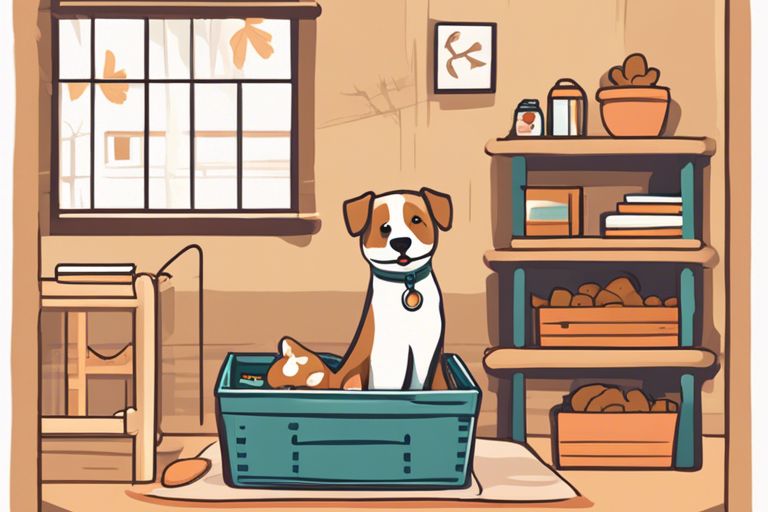Embarking on the jovial journey of crate training your furry companion can be both challenging and rewarding for you and your pet. When done correctly, crate training can provide a safe and comfortable space for your dog, preventing destructive behaviors and anxiety. However, it is essential to approach this training method with patience and consistency. The key to successful crate training lies in understanding your dog’s behavior and implementing the most effective techniques. In this blog post, you will learn the best and most humane methods for crate training your dog, ensuring a positive and stress-free experience for both of you.
Key Takeaways:
- Consistency is key: Establish a consistent routine for your dog’s crate training, including meal times, potty breaks, and playtime. This will help your dog associate the crate with positivity and security.
- Positive reinforcement: Use treats, toys, and praise to positively reinforce your dog’s behavior inside the crate. This will help your dog see the crate as a safe and enjoyable place to be.
- Gradual desensitization: Introduce your dog to the crate gradually, allowing them to explore and become comfortable with it at their own pace. Avoid forcing them into the crate, as this can create negative associations with the space.

Preparing for Crate Training
Assuming you have decided to crate train your dog, there are a few key steps you should take to prepare for this training process. First, you will need to select the right crate for your dog. Additionally, you will need to gather essential crate accessories and establish a crate training schedule.
Choosing the Right Crate
When choosing a crate for your dog, it’s important to consider the size and breed of your dog. The crate should be large enough for your dog to stand up, turn around, and lie down comfortably, but not so large that it allows your dog to eliminate in one corner and retreat to another. A crate with a divider panel can be useful for adjusting the size as your puppy grows. Additionally, opt for a sturdy, well-ventilated crate that provides your dog with a safe and secure den-like space.
Essential Crate Accessories
When crate training your dog, there are a few essential accessories that can aid in the process. A comfortable crate bed or mat provides a cozy space for your dog to rest. Adding a water bowl and some safe, durable chew toys can help keep your dog comfortable and occupied while in the crate. Additionally, covering the crate with a blanket can create a den-like atmosphere, promoting a sense of security.
Establishing a Crate Training Schedule
Establishing a crate training schedule is crucial for success. You should aim to gradually introduce your dog to the crate, starting with short periods of time and gradually increasing the duration. Be sure to schedule regular potty breaks and exercise before crating your dog to minimize accidents and help them settle down. Consistency is key, so make sure to stick to a regular schedule for crate training to prevent confusion and anxiety.
Crate Training Techniques
Despite the misconception that crate training is cruel, it can actually be a useful tool for both you and your dog. The key is to use the crate as a positive, safe space for your dog, and to introduce it gradually. Here are some crate training techniques that can help you effectively train your dog to love their crate.
Introduction to the Crate
When introducing your dog to the crate, it’s important to make it a positive experience. Start by leaving the door open and placing a comfortable blanket or bed inside. Encourage your dog to explore the crate on their own terms, and reward them with treats and praise when they do so. This will help your dog associate the crate with positive experiences.
Gradual Enclosure
Once your dog is comfortable with the open crate, you can begin to gradually enclose them for short periods of time. Start by closing the door for just a few minutes at a time while you are present, offering treats and reassurance to help them feel at ease. Gradually increase the amount of time your dog spends in the crate, always keeping their comfort and safety in mind.
Respect Your Dog’s Needs
It’s important to respect your dog’s natural instincts and avoid using the crate as a punishment. Never force your dog into the crate or leave them inside for extended periods of time. Your dog should see the crate as a safe, comfortable retreat, not as a place of confinement. Additionally, make sure the crate is the right size for your dog, allowing them to stand up, lie down, and turn around comfortably.
Creating a Routine
Consistency is key when crate training your dog. Establish a routine for crate times, such as when you leave the house or at bedtime. By creating a predictable schedule, your dog will become accustomed to their crate and feel secure in their routine. Eventually, your dog may even start to seek out their crate as a place of comfort on their own.
Avoiding Separation Anxiety
Crate training can also help prevent separation anxiety in dogs. By providing a secure, comfortable space for your dog while you are away, you can help alleviate their anxiety and keep them safe from potential destructive behaviors. However, it’s important to gradually build up the amount of time your dog spends in the crate while you are away, and to make sure they receive plenty of exercise and mental stimulation when they are not confined.
Remember, every dog is different, so it’s important to be patient and observe your dog’s behavior throughout the crate training process. With the right techniques and a positive approach, you can help your dog learn to see their crate as a safe, comfortable space.














